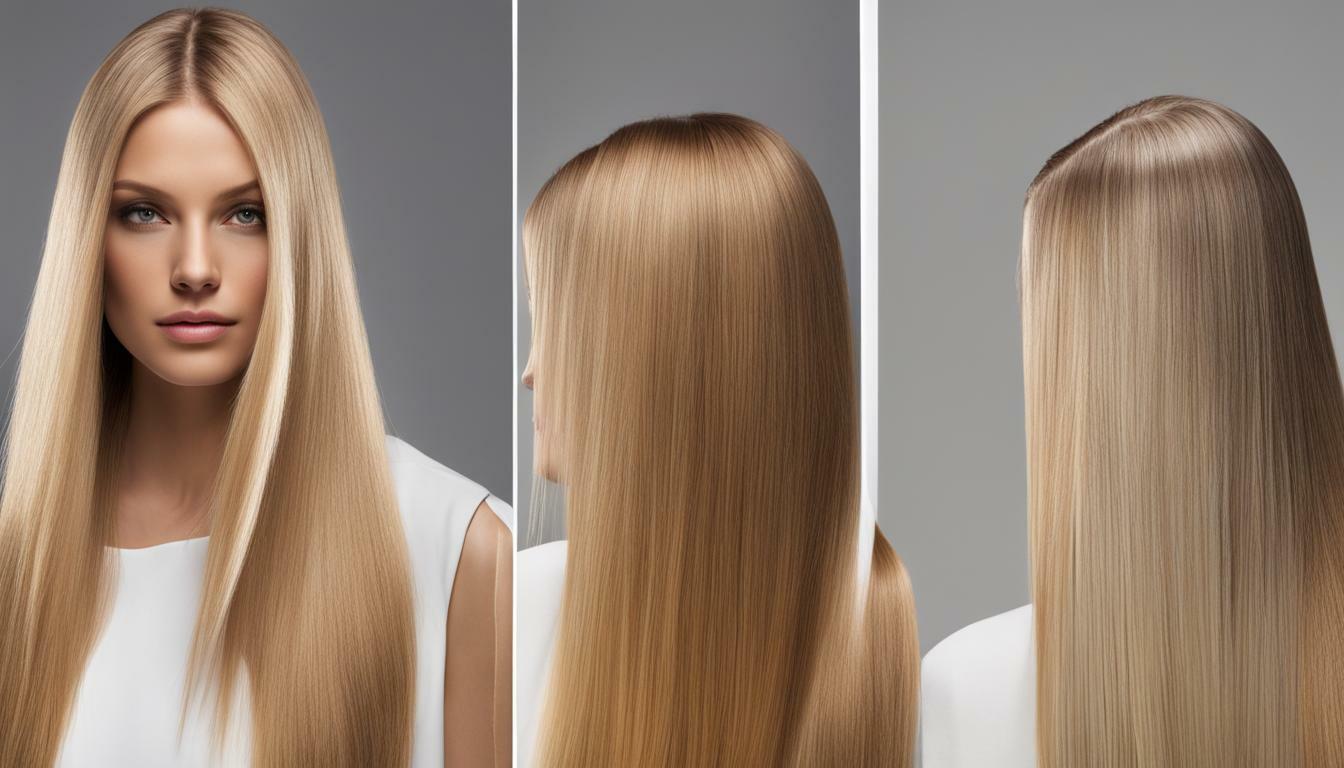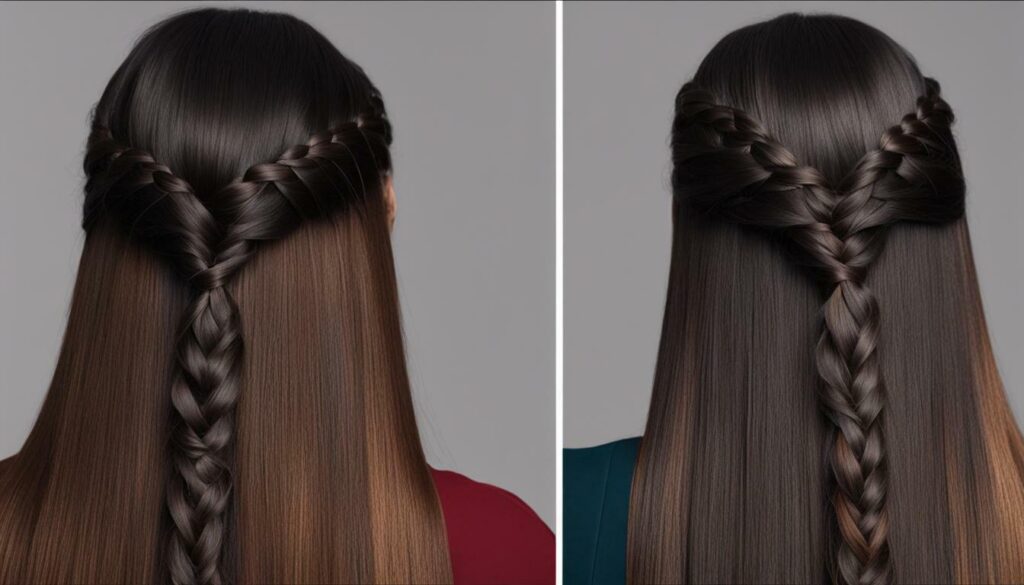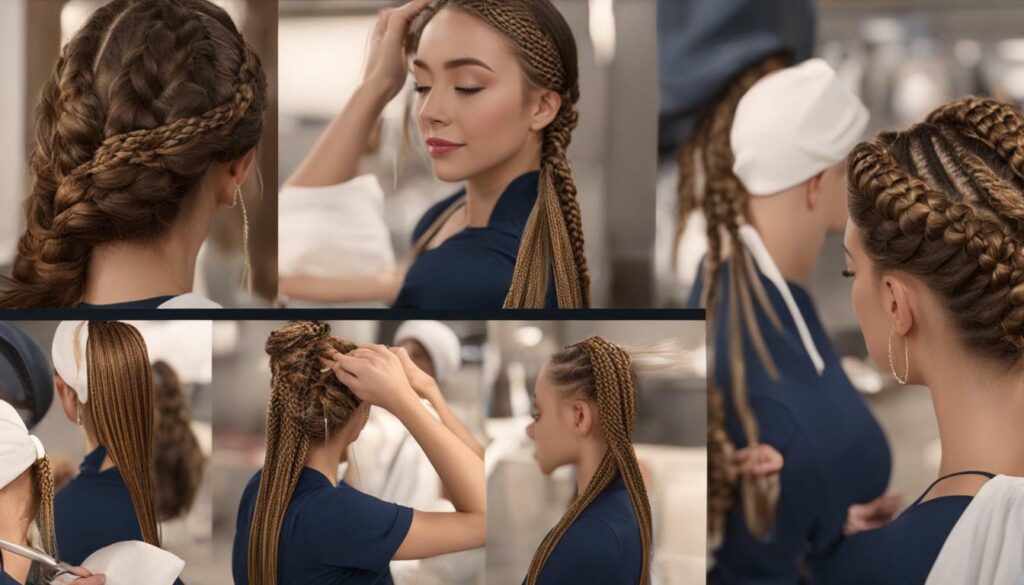
Braiding your hair is a popular hairstyling technique, but many people wonder if it can have negative effects on the health of their hair. While braids can be a great protective style, improper installation or removal can lead to damage or breakage. It’s important to choose a skilled stylist who knows how to install braids without causing harm to your hair.
One technique that can help minimize damage is the knotless braiding technique, which reduces the risk of traction alopecia. Traction alopecia occurs when the hair is pulled too tightly, leading to hair loss. By opting for knotless braids, the tension on your hair is reduced, reducing the chances of damage.
Key Takeaways:
- Choosing a skilled stylist is crucial in preventing hair damage from braids.
- Opting for knotless braids can help minimize the risk of traction alopecia.
- Proper aftercare, including using hydrating products and softening build-up, is essential.
- Avoid excessive styling, as it can weaken and damage the hair.
- Adopting healthy hair habits, such as avoiding tight ponytails and braids, can help prevent damage.
By following these tips and prioritizing the health of your hair, you can enjoy the benefits of braids while minimizing the risk of damage. It’s important to remember that every individual’s hair is unique, so it’s essential to listen to your hair’s needs and adjust your routine accordingly. With proper care and maintenance, you can rock braids without compromising the health of your hair.
Understanding the Potential Damage from Braids
While braids can be a stylish and convenient way to manage your hair, it’s crucial to be aware of the potential damage they can cause. Improper installation or removal of braids can lead to breakage and hair loss. It’s important to choose a stylist experienced in braiding techniques that prioritize the health of your hair.
One common issue with braids is traction alopecia, a condition caused by excessive tension on the hair follicles. This can occur when braids are tightly secured or if the hair is pulled too tightly during the braiding process. Opting for the knotless technique can help minimize the risk of traction alopecia. In this method, the stylist starts each braid with your natural hair, gradually incorporating extensions without applying excessive pressure. This reduces the strain on your hair and scalp, promoting healthier growth.
Proper aftercare is also essential to prevent damage. When removing your braids, be gentle and avoid forcefully pulling or tugging at your hair. Use a hydrating shampoo and conditioner to replenish moisture and softness. Additionally, take care to remove any product build-up, as this can weaken the hair and lead to breakage. Utilize a clarifying shampoo or a vinegar rinse to dissolve any residue, allowing your hair to breathe and regenerate.
It’s important to note that braids are not the only factor that can damage your hair. Excessive styling, such as bleaching, perming, and using heat from flat irons and blow dryers, can weaken and compromise your strands. To protect your hair, limit the use of these styling tools and opt for protective hairstyles like braids when possible. Avoid tight ponytails or braids that can cause tension and breakage, and be mindful of over-brushing or over-shampooing, as these habits can also contribute to hair damage.

- Braids can potentially cause damage if not done correctly or if excessive tension is applied.
- Choose a stylist experienced in braiding techniques that prioritize hair health.
- Opt for the knotless technique to minimize the risk of traction alopecia.
- Practice gentle aftercare when removing braids, using moisturizing products and removing build-up.
- Avoid excessive styling, tight hairstyles, and over-brushing or over-shampooing to minimize damage.
| Braids and Hair Damage | Prevention Tips |
|---|---|
| Traction alopecia | Choose knotless braiding technique |
| Breakage and hair loss | Practice gentle aftercare, use hydrating products |
| Excessive styling | Limit use of heat and styling tools, opt for protective hairstyles |
Minimizing Damage and Maintaining Hair Health
Fortunately, there are steps you can take to protect your hair and minimize damage when wearing braids. Proper care and maintenance are crucial to keep your hair healthy and strong while rocking your favorite braided styles. Here are some essential tips to help you maintain hair health:
- Choose a skilled stylist: When getting braids, it’s important to choose a stylist who has experience in installing braids the right way. An experienced stylist will know how to minimize tension on your hair, reducing the risk of breakage and damage.
- Opt for the knotless technique: The traditional braiding technique can cause traction alopecia, a type of hair loss caused by continuous pulling. To prevent this, consider opting for the knotless technique, which places less tension on the hairline and scalp.
- Practice proper aftercare: After removing your braids, take the time to properly care for your hair. Use hydrating products, such as leave-in conditioners and oils, to restore moisture and prevent dryness. Gently detangle your hair using a wide-tooth comb or your fingers to avoid breakage.
- Avoid excessive styling and heat: Excessive styling, bleaching, perming, and using heat from flat irons and blow dryers can weaken and damage your hair. Limit the use of heat and styling products to protect your hair from unnecessary stress.
- Be mindful of tight hairstyles: Tight ponytails and braids can put excessive tension on your hair, leading to breakage. Opt for looser styles that allow your hair to breathe and minimize tension on the scalp.
- Avoid over-brushing and over-shampooing: Brushing and shampooing your hair excessively can strip away natural oils and cause dryness and breakage. Instead, focus on gentle detangling and washing your hair as needed to maintain its health.
By implementing these tips, you can enjoy your braided hairstyles while minimizing the risk of hair damage. Remember to prioritize hair health over neatness and always listen to your hair’s needs. With proper care and attention, you can maintain the strength and beauty of your hair, even when rocking braids.
Table: Common Braiding Styles and Their Potential Effects on Hair
| Braiding Style | Potential Effects on Hair |
|---|---|
| Box Braids | Risk of breakage if installed too tightly |
| Cornrows | Risk of tension alopecia if braided too tightly or left in for extended periods |
| Twists | Minimal risk if not installed too tightly |
| Braided Extensions/Weaves | Potential for breakage or damage due to the weight of extensions |

Remember, taking care of your hair is essential for maintaining its health and preventing damage. By following these tips and being mindful of how you braid and care for your hair, you can enjoy the beauty and versatility of braided hairstyles while keeping your hair strong and healthy.
Conclusion
By following these guidelines and being mindful of the potential risks, you can enjoy the benefits of braids while minimizing damage to your hair.
Braiding your hair can be a stylish and practical way to protect your strands. However, improper installation or removal techniques can lead to damage or breakage. To ensure the health of your hair, it is important to choose a stylist who is experienced in installing braids the healthy way. Opting for the knotless technique can also help prevent traction alopecia, a condition that results from continuous tension on the hair follicles.
Proper aftercare is essential in minimizing damage caused by braids. Using hydrating products and softening build-up when removing the braids can help prevent dryness and breakage. It is also important to avoid excessive styling, such as bleaching, perming, and using hot tools like flat irons and blow dryers, as these can weaken and damage the hair.
Additionally, certain everyday habits can contribute to hair damage when braiding. Avoid tight ponytails and braids, as these can put unnecessary stress on the hair follicles. Instead, opt for looser styles that prioritize hair health over neatness. Limit the use of heat and styling products, and opt for wide-tooth combs when detangling to minimize breakage.
By taking these precautionary measures and practicing good hair care, you can enjoy the beauty and versatility of braids without compromising the health of your hair. Remember, prevention is key in protecting your hair from damage caused by braiding.
FAQ
Do braids damage your hair?
Braiding your hair can potentially cause damage if not done correctly. Improper installation or removal can lead to damage or breakage.
What are box braids?
Box braids are a popular hairstyle that originated in Africa. They are known as a protective style.
How can I prevent damage from braids?
To prevent damage from braids, it is important to choose a stylist with experience in installing braids the healthy way. Opt for the knotless technique to prevent traction alopecia.
What is the knotless technique?
The knotless technique is a braiding method where the hair is gradually added to the braid without using a knot. This reduces tension and prevents damage to the hairline.
What should I do for proper aftercare?
Proper aftercare for braids includes using hydrating products and softening build-up when removing the braids.
What other habits can cause damage to my hair?
Other habits that can cause damage include tight ponytails and braids, over-brushing, over-shampooing, and using extensions and weaves.
How can I minimize damage to my hair?
To minimize damage, it is recommended to use wide-tooth combs for detangling, avoid braiding too tightly, prioritize hair health over neatness, and limit the use of heat and styling products.






